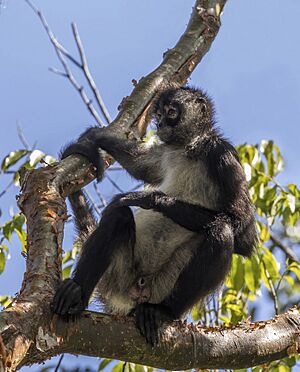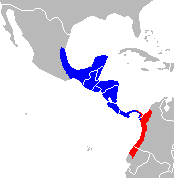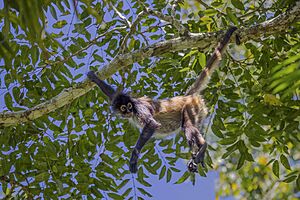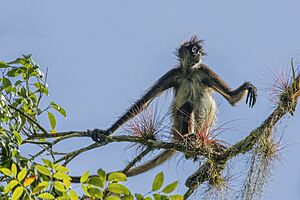Geoffroy's spider monkey facts for kids
Quick facts for kids Geoffroy's spider monkey |
|
|---|---|
 |
|
| Male A. g. yucatanensis, Guatemala | |
| Conservation status | |
| Scientific classification | |
| Genus: |
Ateles
|
| Species: |
geoffroyi
|
| Subspecies | |
|
5, see text |
|
 |
|
| Distribution of A. geoffroyi (blue) and A. fusciceps (red) | |
| Synonyms | |
|
A. frontatus (Gray, 1842) |
|
Geoffroy's spider monkey, also called the black-handed spider monkey, is a type of spider monkey. It's a New World monkey found in Central America, parts of Mexico, and sometimes Colombia. There are at least five different kinds, called subspecies. Some scientists think the black-headed spider monkey is the same species.
This monkey is one of the biggest New World monkeys. It can weigh up to 9 kg (20 lb). Its arms are much longer than its legs. Its special prehensile tail can hold the monkey's whole weight. It acts like an extra arm! The monkey's hands have a very small thumb. But its fingers are long and strong, like hooks. These features help the monkey swing easily through trees.
Geoffroy's spider monkeys live in groups of 20 to 42 members. These groups often split into smaller teams to find food. They mostly eat ripe fruit. They need large areas of forest to live. Sadly, their homes are shrinking. They are also hunted and caught for pets. Because of this, the IUCN says they are an endangered species.
Contents
What is a Geoffroy's Spider Monkey?
Geoffroy's spider monkey belongs to the New World monkey family called Atelidae. This family includes spider monkeys, woolly monkeys, muriquis, and howler monkeys. It is part of the Ateles group, which includes all spider monkeys. The name Ateles means "imperfect." This refers to their very small thumb. The name geoffroyi honors a French scientist named Étienne Geoffroy Saint-Hilaire.
Different Kinds of Spider Monkeys
Scientists don't always agree on how many spider monkey species there are. Some early studies looked at fur color and where the monkeys lived. More recent studies use mitochondrial DNA to tell species apart. These studies show that Geoffroy's spider monkey is closely related to the white-fronted spider monkey and the brown spider monkey. They are not as closely related to the red-faced spider monkey.
In 2005, a big book about mammals listed five types of Geoffroy's spider monkey. These are called subspecies:
- Nicaraguan spider monkey, Ateles geoffroyi geoffroyi
- Hooded spider monkey, A. g. grisescens
- Ornate spider monkey, A. g. ornatus
- Mexican spider monkey, A. g. vellerosus
- Yucatan spider monkey, A. g. yucatanensis
Some scientists also think the black-headed spider monkey is a separate species. Others believe it is just another type of Geoffroy's spider monkey.
Where Do They Live?
The Geoffroy's spider monkey lives across much of Central America. You can find them in Panama, Costa Rica, Nicaragua, Guatemala, Honduras, El Salvador, Belize, and parts of Mexico. People have also seen the southernmost type, the hooded spider monkey, near the Panama border in Colombia.
These monkeys live in many kinds of forests. This includes rainforests, forests that lose some leaves, and mangrove forests. They are usually found in larger numbers in evergreen forests.
What Do They Look Like?
Geoffroy's spider monkey is one of the biggest New World monkeys. Its body is between 30 and 63 cm (12 and 25 in) long. It weighs between 6 and 9 kg (13 and 20 lb). Its tail is even longer than its body, measuring 63 and 85 cm (25 and 33+1⁄2 in). Males and females are about the same size.
Their fur color changes depending on the subspecies and where they live. It can be buff (light yellow-brown), reddish, rust, brown, or black. Their hands and feet are usually dark or black. Their face often has a pale mask. The skin around their eyes and nose is bare.
Their arms and legs are long and thin. Their arms are about 25% longer than their legs. They have a very small thumb, but their fingers are long and strong. This makes their hands look like hooks. These long arms and hook-like hands help them brachiate. This means they swing by their arms under tree branches.
Their prehensile tail is very strong. It has a pad like a palm at the end. The tail works like an extra limb. They use it to move around, pick fruits, and even scoop water from holes in trees. Geoffroy's spider monkey can hang by its tail alone. They often do this while eating.
How Do They Behave?
Geoffroy's spider monkeys live in trees and are active during the day. They mostly stay in the upper parts of the forest. But they come to the ground more often than other spider monkeys. They live in large groups of 20 to 42 members. These groups split into smaller teams to find food during the day. These smaller teams usually have two to six members. Sometimes, these small groups even stay separate overnight.
These monkeys search for food over large areas of forest. A group's home range can be bigger than 900 hectares (2,200 acres). Monkeys can travel about 2,000 metres (6,600 ft) each day. Males tend to travel farther than females. Sometimes, Geoffroy's spider monkeys rub a mix of saliva and ground lime tree leaves on their fur. People think this helps keep insects away. In some places, they even groom other monkeys like the white-headed capuchin.
How They Move Around
Geoffroy's spider monkeys can walk or run on all four limbs and climb. But they also use several ways to hang and move. Swinging from their arms, with help from their tail, is the most common way. They can also swing while hanging only by their tail. Sometimes, they walk on all four limbs under a branch. Studies show they swing less often than other spider monkey species.
The most common way they cross between trees is by "bridging." The monkey grabs a branch from the new tree and pulls it closer. Then it climbs onto it. They will leap through the air if they have to. Some groups, especially in Panama, are known to leap between trees more often.
When they are not moving, they sit or stand. But they also hang from branches. When they hang, they always use their tail for support. Sometimes, they hang only by their tail. Other times, they hang by their tail and one or more limbs.
Talking and Thinking
Geoffroy's spider monkeys make many sounds. These include barks, whinnies, squeals, squeaks, and screams. Barks are usually alarm calls. Whinnies and screams can be signs of distress. They also make these sounds at dawn and dusk. Each monkey has a unique sound. This might help them recognize each other just by listening. Scientists have studied their whinnies in detail. These sounds have two to twelve quick changes in pitch. They use whinnies to call other group members to food. They also use them to stay in touch while traveling. And they help tell their group members from other groups.
They also use body language to communicate. A curled tail or an arched back can be a threat to other spider monkeys. Shaking their head can be a threat or an invitation to play. Shaking branches or swaying their arms warns the group of danger.
Spider monkeys, including Geoffroy's spider monkey, are very smart. Even though they don't use tools, a 2007 study found them to be the third smartest non-human primate. They were smarter than gorillas and other monkeys. Only orangutans and chimpanzees were smarter. This intelligence might help them find food. They need to remember many different types of fruits and where to find them.
What Do They Eat?
Geoffroy's spider monkeys mostly eat fruit. They prefer ripe, juicy fruits. They spend 70–80% of their feeding time eating fruit. Leaves make up most of the rest of their diet. Young leaves are important for protein, which fruit might not have enough of. They also eat flowers, bark, insects, honey, seeds, and buds.
Fruit and leaves provide most of the water they need. Like other spider monkeys, they drink water from tree holes and plants called bromeliads. But unlike other spider monkeys, they also drink from water sources on the ground.
Who Are Their Predators?
Big cats like jaguars and pumas are the main predators of adult spider monkeys. Humans are also a threat. Eagles and large snakes might also hunt them. However, scientists have not seen predators attacking Geoffroy's spider monkeys.
Reproduction and Life Cycle
Female spider monkeys have babies every two to four years.
The mother carries the baby for about 7.5 months. Usually, one baby is born, but sometimes twins happen. Young monkeys are dark in color. They start to get their adult color at about five months old. For the first one to two months, they ride on their mother's chest. After that, they can ride on her back. They drink milk until they are about one year old. But they start eating solid food and moving on their own at about three months. Even when they move alone, they can't always cross gaps in the trees that adults can. To help them, an adult will stretch across the gap. This forms a bridge for the young monkey to cross.
We don't know how long they live in the wild. But in zoos, Geoffroy's spider monkeys can live for at least 33 years.
Why Are They Endangered?
The IUCN lists Geoffroy's spider monkey as an endangered species. This is mainly because they are losing their homes and are caught for the pet trade. They need large areas of old, untouched forest to survive. So, they are in danger from deforestation (when forests are cut down). They are also sometimes hunted by people. Because they don't have many babies often, their numbers can't grow back quickly after these problems. As a result, Geoffroy's spider monkey has disappeared from some places where it used to be common. Three of their subspecies are critically endangered.
Geoffroy's spider monkeys disappeared from Barro Colorado Island in Panama. Hunting had wiped out the monkeys there by 1912. But between 1959 and 1966, people tried to bring the species back to the island. At least 18 monkeys were brought back. Only five, one male and four females, survived. This small group has done very well. By 2003, the island's monkey population had grown to 28.
In Culture
- The Mexican painter Frida Kahlo's painting Self-Portrait with Monkey 1938 shows this species. The artist kept several of them as pets.





